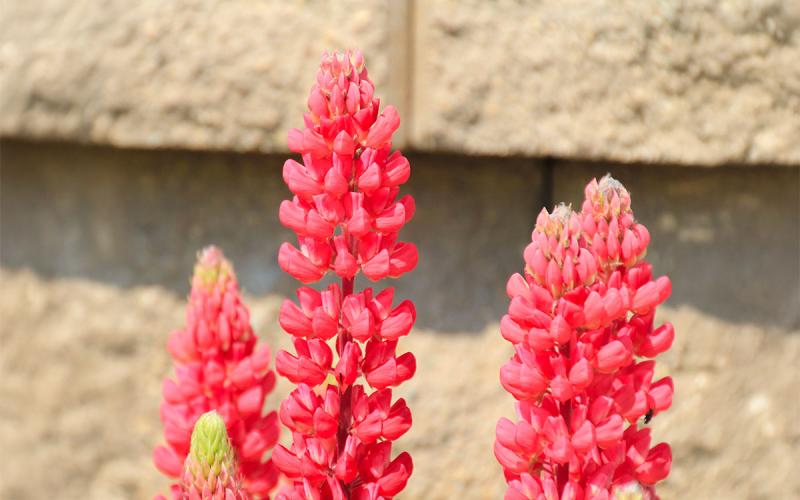Original article by David Graper, former SDSU Extension Horticulture Specialist and Master Gardener Program Coordinator. Updated by Vaughn Reints, SDSU Extension Horticulture Assistant; Max Peterson, SDSU Extension Master Gardener Trainee; and Kristine Lang, Assistant Professor, Agronomy, Horticulture, and Plant Science.
Lupines (Lupinus), a genus of plants in the legume family Fabaceae, are popular plants in the United States. One species, the famous Bluebonnets, even serves as the state flower of Texas. While Bluebonnets are not hardy here, there are several cultivars that will survive in the Northern Great Plains. The name Lupine is derived from the word lupus, a wolf.
Varieties and Characteristics

Another popular group of lupines, the Russell Hybrids, were developed by George Russell, a home gardener in England. The Russell hybrids are available in a wide variety of colors. Another excellent series is Tutti Frutti, which offers a great selection of colors, including white, pink, red, burgundy, lavender, blue, purple, and yellow. The flowers are borne in terminal spikes (racemes) that are 1.5 to 3 feet tall and held nicely above the foliage. Individual flowers are pea-like, and measure about 0.5 inches long. They make good cut-flowers.
The foliage is palmately compound, with 9 to 16 lanceolate to oblanceolate leaflets per leaf. The leaves are attached to the base of the stems by 6- to 12-inch-long petioles. One interesting aspect of these plants is that a large droplet of water will often be caught in the center of the leaf. Besides the Russell Hybrids, which will generally grow to about 30 inches in height, the Minarett series offers dwarf size plants in a variety of colors, growing to 20 inches in height. Red Flame has carmine red flowers and grows 40 inches tall. The Governor has marine-blue flowers with white flags, and grows 30 inches tall. On the other hand, Blushing Bride has pure-white flowers.
Lupines come in two main categories: sweet and bitter. The categories are distinguished by their alkaloid content and usage. Understanding the differences between these types is crucial for choosing the right variety for specific needs.
Sweet Lupines
Sweet lupines have been bred to contain low levels of alkaloids, which makes this category of lupines safe for human consumption and also for animal feed.
This category of lupines offers a high-protein, nutrient-rich plant option. Sweet lupines can also be safely incorporated in food products, as well as used for improving the health of the soil in crop rotations.
Bitter Lupines
Bitter lupines, on the other hand, naturally contain high levels of alkaloids, and without processing are toxic and unsuitable for consumption. These varieties are often grown for ornamental purposes, as cover crops, or for green manure, contributing to soil fertility and structure. When managing rangelands with lupine presence, it is important to limit livestock grazing, as consuming certain species can be potentially lethal to animals.
Additional Benefits of Lupines

In addition to their aesthetic value, lupines provide a variety of benefits to the garden. As legumes, they naturally enrich the soil by fixing nitrogen, potentially reducing the need for synthetic fertilizers, and by improving soil structure. Their deep roots help break up compacted soils, enhance water infiltration, and stabilize soil on slopes to prevent erosion. Once established, lupines are relatively drought-tolerant, making them a great choice for gardens that require low-water plants.
Lupines also support a healthy ecosystem by attracting pollinators, such as bees and butterflies, as well as beneficial predatory insects like ladybugs and hoverflies. Their tall, colorful flower spikes add vertical interest to flower beds and mixed borders in the landscape. Native varieties can enhance local biodiversity and provide habitat for wildlife, including certain species of caterpillars and butterflies.
Lupines are versatile and beneficial for nitrogen-hungry vegetables, as they help improve soil health. While their main nitrogen contribution occurs after decomposition, they also enhance soil structure when grown as a cover crop and when used as green manure. Thriving in a variety of conditions, including sandy or rocky soils where other plants may struggle, lupines are both an attractive and functional addition to any garden.
Care and Management

Lupines like neutral to slightly alkaline soil, cool temperatures, and moist soil. They can easily be propagated by seed but will not bloom until the following season. Unfortunately, lupines are often not very long-lived in the Upper Great Plains, but they can still put on quite a show for a few years. Give the plants a good winter mulch to help them survive our cold temperatures. Powdery mildew is likely the most common disease affecting lupines, and aphids can be a pest, though neither typically poses a serious threat. Lupines have been grown successfully at McCrory Gardens in Brookings, South Dakota, typically blooming in June. The lupines are planted in a moist site that is drip-irrigated and receives snow cover during winter.
References and Resources
- Lupines, A New Crop, SDSU Extension.
- Poisonous Plants on Rangelands: Deathcamas and Lupine, SDSU Extension.
- Lupinus albus L., U.S. Department of Agriculture.


